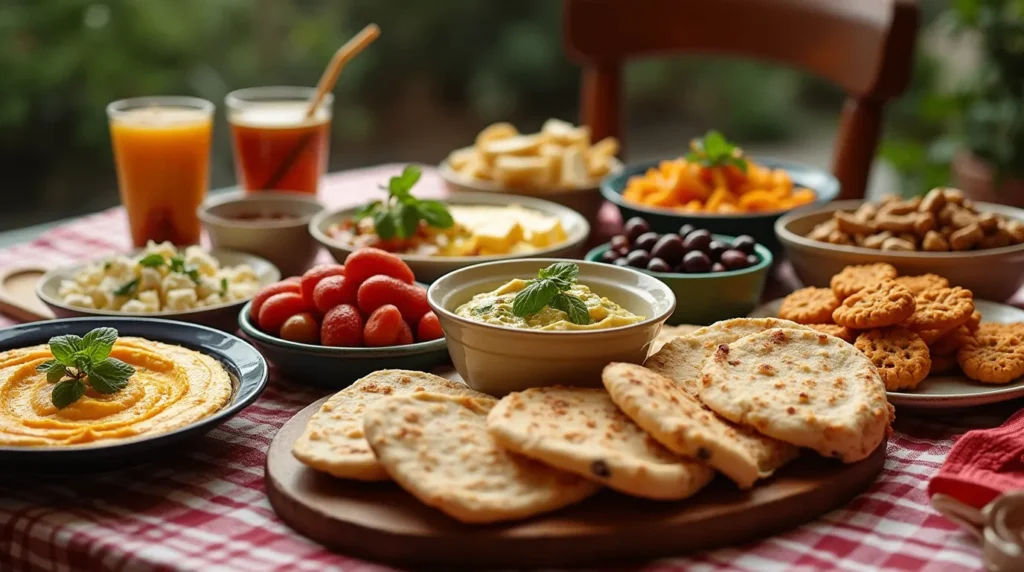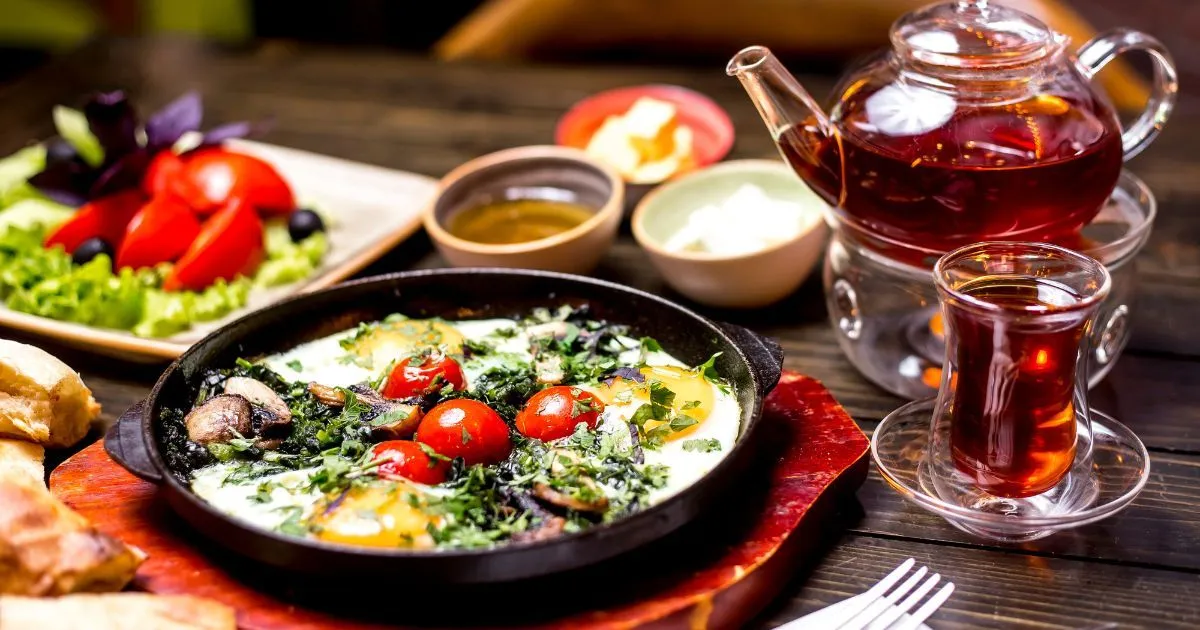Imagine waking up to the rich aroma of freshly baked bread, warm spices, and creamy hummus, all laid out on a beautifully arranged table. A Middle Eastern breakfast is not just a meal; it’s a celebration of flavors, culture, and tradition. If you love exploring global cuisines or want to add variety to your morning routine, you’re in for a treat.
Table of Contents
Middle Eastern breakfasts are diverse, packed with nutrients, and bursting with authentic flavors. Whether you prefer savory dishes like Shakshuka or something lighter like Labneh with Olive Oil, there’s something for everyone. In this guide, you’ll discover the most popular Middle Eastern breakfast dishes, their health benefits, and how you can prepare them at home.

What Makes Middle Eastern Breakfast Special?
Middle Eastern breakfasts stand out for their diverse flavors, wholesome ingredients, and communal dining style. Unlike the grab-and-go breakfast culture in some places, these meals are meant to be savored slowly, often with friends and family. Here’s what makes them unique:
- Fresh Ingredients – Olive oil, fresh herbs, nuts, and high-quality dairy products form the backbone of these meals.
- Balanced Nutrition – A perfect mix of protein, fiber, and healthy fats.
- Rich Culinary Heritage – Recipes passed down for generations, each with a unique cultural story.
- Wide Variety – From hearty bean dishes to light yogurt-based spreads, you’ll never run out of options.
- Breakfast as a Social Experience – Unlike in Western cultures where breakfast can be rushed, Middle Eastern breakfasts are enjoyed as a social gathering, fostering warmth and togetherness.
- Seasonal Influences – Many traditional dishes change with the seasons, incorporating fresh produce and herbs that enhance both flavor and nutritional value.
Must-Try Middle Eastern Breakfast Dishes
1. Ful Medames (Fava Bean Stew)
A staple dish across the Middle East, Ful Medames is a protein-packed breakfast made from slow-cooked fava beans, garlic, and lemon juice.
How to Make Ful Medames
| Ingredient | Quantity |
|---|---|
| Cooked fava beans | 2 cups |
| Garlic (minced) | 2 cloves |
| Lemon juice | 2 tbsp |
| Olive oil | 3 tbsp |
| Cumin | 1 tsp |
| Salt & pepper | To taste |
Instructions:
- Mash the fava beans slightly for a creamy texture.
- Stir in garlic, lemon juice, and olive oil.
- Sprinkle cumin, salt, and pepper.
- Serve warm with pita bread and fresh veggies.
- Garnish with fresh parsley and a drizzle of olive oil for added flavor.
Health Benefits:
- Rich in fiber and protein, making it a filling breakfast option.
- Contains iron and folate, essential for energy production.
- Supports heart health due to its high fiber and low cholesterol content.
2. Shakshuka (Poached Eggs in Tomato Sauce)
A one-pan dish featuring eggs poached in a spiced tomato sauce. Originating from North Africa, it has become a breakfast favorite across the Middle East.
Shakshuka Recipe
| Ingredient | Quantity |
| Eggs | 4 |
| Tomatoes (diced) | 2 cups |
| Onion (chopped) | 1 |
| Garlic (minced) | 3 cloves |
| Cumin | 1 tsp |
| Paprika | 1 tsp |
| Olive oil | 2 tbsp |
Instructions:
- Sauté onions and garlic in olive oil until fragrant.
- Add diced tomatoes, spices, and let simmer.
- Crack eggs into the sauce and cover until set.
- Serve hot with bread and feta cheese.
- Garnish with chopped parsley or cilantro for a fresh touch.
Why You Should Try It:
- Combines protein and antioxidants for a nutrient-rich meal.
- Perfect comfort food that’s both satisfying and easy to make.
- Can be customized with spicy harissa or bell peppers for extra flavor.
3. Manakish (Middle Eastern Flatbread with Za’atar)
Often referred to as the Middle Eastern pizza, Manakish is a soft, chewy flatbread topped with za’atar, cheese, or minced meat.
How to Enjoy Manakish
- Za’atar Manakish – A mix of thyme, sesame, and sumac with olive oil.
- Cheese Manakish – Topped with Akkawi or Nabulsi cheese.
- Meat Manakish – Minced beef or lamb with spices.
- Health Benefits: Provides a balance of carbohydrates, fats, and protein, making it a well-rounded meal.

4. Labneh with Olive Oil & Za’atar
Labneh is a strained yogurt spread with a creamy texture, typically enjoyed with fresh bread.
Why You Should Try Labneh:
- High in probiotics, great for gut health.
- Pairs well with olives, cucumbers, and tomatoes.
- Light yet satisfying.
- Contains calcium and protein, essential for bone health.
5. Hummus & Pita Bread
No Middle Eastern breakfast is complete without hummus—a smooth, creamy dip made from chickpeas and tahini.
Classic Hummus Recipe
| Ingredient | Quantity |
| Chickpeas | 2 cups |
| Tahini | ¼ cup |
| Lemon juice | 2 tbsp |
| Garlic | 2 cloves |
| Olive oil | 3 tbsp |
| Salt | To taste |
Instructions:
- Blend all ingredients until smooth.
- Drizzle with olive oil and garnish with paprika.
- Serve with warm pita bread.
Additional Uses:
- As a dip for fresh vegetables.
- Spread on sandwiches for extra flavor.
Conclusion
Middle Eastern breakfasts are flavorful, nutritious, and easy to prepare. Whether you’re craving a protein-packed meal like Ful Medames or a simple spread like Labneh, these dishes will elevate your morning routine. Why not try making one at home today?

